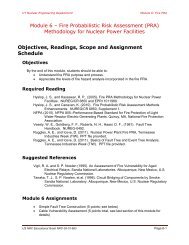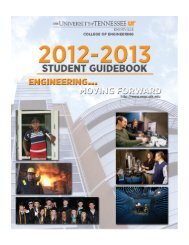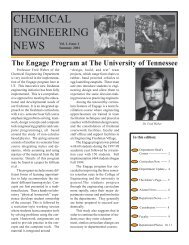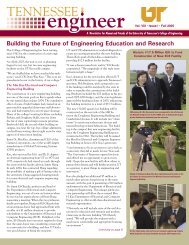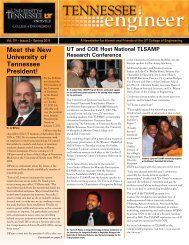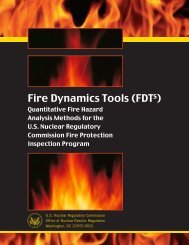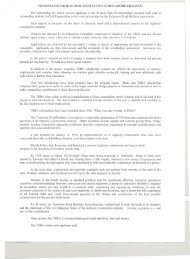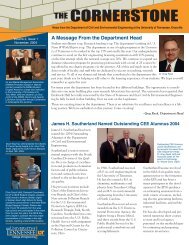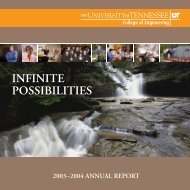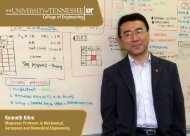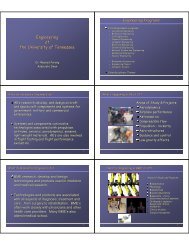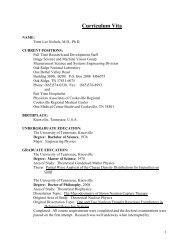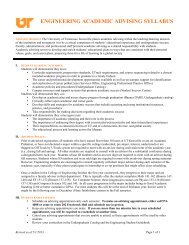Fall 2011 - College of Engineering - The University of Tennessee ...
Fall 2011 - College of Engineering - The University of Tennessee ...
Fall 2011 - College of Engineering - The University of Tennessee ...
Create successful ePaper yourself
Turn your PDF publications into a flip-book with our unique Google optimized e-Paper software.
Nuclear <strong>Engineering</strong><br />
Faculty Member is<br />
Chancellor’s Pr<strong>of</strong>essor<br />
Dr. Larry Townsend<br />
In April <strong>2011</strong>, Chancellor Jimmy Cheek<br />
named Dr. Larry Townsend, Robert M.<br />
Condra Pr<strong>of</strong>essor in the Department <strong>of</strong><br />
Nuclear <strong>Engineering</strong> (NE), as one <strong>of</strong> the<br />
five senior faculty members who make up<br />
the new class <strong>of</strong> Chancellor’s Pr<strong>of</strong>essors.<br />
This is the university’s highest permanent<br />
academic honor.<br />
Townsend’s work in space radiation<br />
protection and transport codes has been<br />
used by NASA’s Cosmic Ray Telescope for<br />
the Effects <strong>of</strong> Radiation (CRaTER) project<br />
team, part <strong>of</strong> the Lunar Reconnaissance<br />
Orbiter (LRO) spacecraft and by the<br />
NASA Space Radiation Analysis Group,<br />
which handles radiation exposure<br />
monitoring for astronauts on manned space<br />
missions. Townsend was a senior research<br />
scientist and radiation expert at NASA<br />
before coming to UT and recently has been<br />
an expert source for the media on radiation<br />
sickness symptoms in light <strong>of</strong> the nuclear<br />
crisis in Japan.<br />
<strong>The</strong> Chancellor’s Pr<strong>of</strong>essors program began<br />
in 2008 and provides honorees with a onetime<br />
research stipend <strong>of</strong> $20,000. For more<br />
information on the program, please visit<br />
http://chancellor.utk.edu/pr<strong>of</strong>essors/.<br />
COE Faculty Members Receive NSF CAREER Awards<br />
Dr. Christopher Cherry<br />
Dr. Veerle Keppens<br />
Dr. Wei He<br />
Dr. Christopher Cherry, an assistant pr<strong>of</strong>essor in the Department <strong>of</strong> Civil and Environmental<br />
<strong>Engineering</strong> (CEE), and Dr. Wei He, an assistant pr<strong>of</strong>essor in both the Department <strong>of</strong> Materials<br />
Science and <strong>Engineering</strong> (MSE) and the Department <strong>of</strong> Mechanical, Aerospace and Biomedical<br />
<strong>Engineering</strong> (MABE), have received National Science Foundation (NSF) Faculty Early Career<br />
Development (CAREER) awards.<br />
Cherry’s award, which he received for his project, “Sustainability Implications <strong>of</strong> Transportation<br />
Choice in China,” is effective from April 1, <strong>2011</strong>, until March 31, 2016.<br />
He’s award, which she received for her project, “Immunologically Responsive <strong>The</strong>rapeutic Biomaterials<br />
to Modulate Wound Healing in the Nervous Systems: An Integrated Research and Education Plan,” is<br />
effective from Aug. 1, <strong>2011</strong>, until July 31, 2016.<br />
<strong>The</strong> CAREER award is one <strong>of</strong> the NSF’s most prestigious, supporting junior faculty who exemplify<br />
the role <strong>of</strong> teacher-scholars through outstanding research, excellent education and the integration <strong>of</strong><br />
education and research within the context <strong>of</strong> the mission <strong>of</strong> their organizations.<br />
Dr. Veerle Keppens Elected ASA Fellow<br />
Dr. Veerle Keppens, associate pr<strong>of</strong>essor in<br />
the Department <strong>of</strong> Materials Science and<br />
<strong>Engineering</strong> (MSE), has been elected a Fellow<br />
<strong>of</strong> the Acoustical Society <strong>of</strong> America (ASA)<br />
“for the application <strong>of</strong> ultrasonics to condensed<br />
matter physics.”<br />
Keppens’ research focuses on using ultrasound<br />
to understand fundamental properties <strong>of</strong><br />
materials. She has co-organized special sessions<br />
at the ASA meetings and given lectures at the<br />
Physical Acoustics Summer School (PASS) the<br />
past few years.<br />
Keppens will be featured in the Journal <strong>of</strong> the<br />
Acoustical Society <strong>of</strong> America and honored at a<br />
meeting in San Diego in November <strong>of</strong> this year.<br />
<strong>The</strong> ASA is dedicated to increasing and<br />
diffusing the knowledge <strong>of</strong> acoustics and its<br />
practical applications.<br />
Dr. Benjamin Blalock, Electrical <strong>Engineering</strong> and Computer Science<br />
Dr. Benjamin Blalock, associate pr<strong>of</strong>essor in<br />
the Department <strong>of</strong> Electrical <strong>Engineering</strong> and<br />
Computer Science (EECS) said it was the<br />
“twinkle” in his father’s eye that contributed to his<br />
passion for engineering.<br />
Blalock’s father was a <strong>University</strong> <strong>of</strong> <strong>Tennessee</strong><br />
(UT) engineering pr<strong>of</strong>essor, so he remembers the<br />
stories his dad would share at the dinner table after<br />
Blalock’s mother asked about his day at work.<br />
“His enthusiasm was contagious,” Blalock said.<br />
“His eyes would light up, and he would describe<br />
his latest research progress or something significant<br />
one <strong>of</strong> his students had recently achieved.”<br />
His father’s excitement for engineering, coupled<br />
with the enjoyment Blalock received as a teaching<br />
assistant in the undergraduate electronics lab as<br />
a senior electrical engineering student at UT,<br />
opened his eyes to the possibility <strong>of</strong> becoming an<br />
engineering pr<strong>of</strong>essor.<br />
“This made me realize that I would truly enjoy<br />
teaching electronics and working with students,”<br />
Blalock said. “Ultimately it confirmed my decision<br />
to pursue a Ph.D. in electrical engineering and a<br />
career in academia.”<br />
Blalock received his B.S. degree in electrical<br />
engineering from UT in 1991, and his M.S. and<br />
Ph.D. degrees, also in electrical engineering, from<br />
the Georgia Institute <strong>of</strong> Technology in 1993 and<br />
1996, respectively. He then joined the faculty<br />
at Mississippi State <strong>University</strong> as an assistant<br />
pr<strong>of</strong>essor in electrical engineering.<br />
What attracted him to UT was its strong legacy in<br />
analog electronics.<br />
“Coming to UT represented a unique challenge<br />
to perpetuate that legacy,” Blalock said. “I was<br />
attracted to the strengths <strong>of</strong> the EECS department,<br />
both in teaching and research. You always want<br />
to surround yourself with strong individuals, as<br />
they will challenge you to keep growing. And<br />
admittedly, as a UT undergraduate alumnus, I have<br />
a s<strong>of</strong>t spot for UT. I have always appreciated the<br />
foundation my teachers at UT provided.”<br />
Blalock is the director for the Integrated Circuits<br />
and Systems Laboratory (ICASL), where much <strong>of</strong><br />
his research takes place.<br />
“My research focus is primarily analog/mixed-signal<br />
integrated circuit design for extreme environments<br />
(both wide temperature and radiation) on CMOS,<br />
SOI CMOS and SiGe BiCMOS technology<br />
platforms; high-temperature/high-voltage gate<br />
drive circuits for power electronics; multi-channel<br />
monolithic instrumentation systems; mixed-signal/<br />
mixed-voltage circuit design for systems-on-a-chip;<br />
and analog circuit techniques for sub 100-nm<br />
CMOS,” Blalock said.<br />
One <strong>of</strong> the ICASL’s recent accomplishments is<br />
its quad op amp microchip for the NASA and<br />
Dr. Ben Blalock (left) works with students Matt Laurence (center) and Austin Womac (right) in his ICASL laboratory.<br />
Jet Propulsion Laboratory (JPL) Mars Science<br />
Laboratory (MSL) Rover. This analog chip has<br />
been flight qualified by the JPL. More than 200<br />
copies <strong>of</strong> the chip are used throughout the MSL<br />
Rover.<br />
“This long-range rover is due to be launched to<br />
Mars in the near future,” Blalock said. “Developed<br />
within the ICASL, the quad op amp microchip is<br />
capable <strong>of</strong> enduring daily extreme temperatures<br />
cycling from minus 140 degrees Celsius to 120<br />
degrees Celsius for at least 500 days, which is the<br />
MSL Rover’s mission life target.”<br />
To meet this challenge, two <strong>of</strong> Blalock’s ICASL<br />
research students, Stephen Terry and Robert<br />
Greenwell, developed new analog design<br />
techniques and strategies to ensure long-term<br />
reliability within extreme environments.<br />
In the classroom, Blalock says he hopes to instill<br />
a strong understanding <strong>of</strong> fundamental concepts<br />
and principles and sufficient self-confidence in<br />
applying them toward problem solving.<br />
“I hope my students will have the tools they need<br />
to tackle new analytical challenges throughout<br />
their careers,” Blalock said. “This is part <strong>of</strong> the<br />
reason why my electronics colleagues and I believe<br />
strongly in a project-oriented curriculum with<br />
open labs for specification-driven hardware design,<br />
development and testing, rather than curriculum<br />
with cookbook recipe-style laboratory exercises.”<br />
Blalock says working with students remains at the<br />
top <strong>of</strong> his list when it comes to his job.<br />
“I genuinely think it is fun to teach electronics<br />
and enjoy an interactive classroom,” Blalock said.<br />
“A colleague <strong>of</strong> mine once said, ‘I teach for free,<br />
but they must pay me to grade.’ I wholeheartedly<br />
agree with that statement.”<br />
Blalock enjoys working with students through<br />
research, too.<br />
“For me, most <strong>of</strong> ‘academic freedom’ is the freedom<br />
to pursue research you find exciting and/or<br />
beneficial to the students on your research team,”<br />
Blalock said. “I have been fortunate that most <strong>of</strong><br />
the research my team has conducted has provided<br />
valuable experience for the students prior to<br />
graduation. Research is an important aspect <strong>of</strong> the<br />
educational process, both for students and faculty.”<br />
<strong>The</strong> students and faculty will soon continue<br />
that research in the new Min H. Kao Electrical<br />
<strong>Engineering</strong> and Computer Science Building,<br />
which is projected to be finished and turned<br />
over to the university in September. <strong>The</strong> EECS<br />
department is scheduled to migrate its <strong>of</strong>fices and<br />
labs into the building after the start <strong>of</strong> 2012.<br />
“<strong>The</strong> new building will help us expand our<br />
research efforts,” Blalock said. “And our teaching<br />
efforts should benefit from the new classrooms.<br />
<strong>The</strong> new building certainly represents an<br />
unprecedented opportunity for our department and<br />
college. My hope for the EECS department is that<br />
we would fully capitalize on this new opportunity<br />
toward providing a world-class program for our<br />
students.”<br />
Blalock has received many awards while at UT,<br />
including his recent <strong>2011</strong> <strong>College</strong> <strong>of</strong> <strong>Engineering</strong><br />
Teaching Fellow Award. In 2009, he received<br />
the Gonzales Family Award for Excellence in<br />
Teaching, and in 2007, he received both the Moses<br />
E. and Mayme Brooks Distinguished Pr<strong>of</strong>essor<br />
Award and the Chancellor’s Research and<br />
Creative Achievement Award.<br />
When he’s not in the lab or the classroom, Blalock<br />
enjoys spending time with his wife and two sons.<br />
As an assistant scoutmaster for Boy Scout Troop<br />
179, he recently completed a 10-night, 68-mile<br />
backpacking trek at Philmont Scout Ranch in<br />
northeastern New Mexico.<br />
4 THE UNIVERSITY OF TENNESSEE KNOXVILLE, COLLEGE OF ENGINEERING • www.engr.utk.edu TENNESSEE engineer • <strong>Fall</strong> <strong>2011</strong> • www.engr.utk.edu<br />
5




